Abstract
As medical technology continues to evolve, the importance of real-time feedback from physiological signals is increasingly being recognized. The advent of the Internet of Things (IoT) has facilitated seamless connectivity between sensors and virtual networks, enabling the integration of thoughtful medical care with real-time feedback capabilities. This project uses cloud storage technology and cloud software algorithms to enable data sharing and real-time feedback. Its main focus is to provide a system for real-time feedback on physiological signals and sleep quality analysis. The system uses smart wristbands and smart mobile devices to collect, transmit, and analyze physiological data. During sleep, users wear these devices, which capture and analyze their physiological data. The analyzed data are then stored in a cloud-based database. The research involves studying sleep quality and determining optimal sleep quality parameters based on the data stored in the cloud database. These parameters are designed to improve sleep quality. They are then transmitted to a mobile sleep aid device to control light conditions. The sleep aid software used in previous generations of mobile devices is the basis for expanding the integration of the sleep detection system. By combining the software of a mobile device platform with that of a smart wearable device, data can be obtained to monitor the wearer’s movements, such as turning over and heartbeat. The monitoring aspect includes tracking the turning time, distance, and speed, while the heartbeat monitoring includes detecting changes in heart rate, frequency, and interval using photoplethysmography (PPG) and smart wearable devices. Subsequently, artificial intelligence methods are employed to conduct statistical analysis and categorize the gathered extensive dataset. The system reads the data and provides the user with assessments and suggestions to improve sleep quality and overall sleep condition.
1. Introduction
Sleep has always been an essential part of human life. Everyone needs sleep, whether a head of state, scientist, politician, doctor, office worker, or anyone else. Sleep deprivation not only affects reaction speed, emotional control, memory, vitality, and physiological lesions [1,2,3,4], but also has a significant impact on the occurrence of traffic accidents and crew deployment [5,6,7]. In 2018, a study by David Hillman et al. indicated that inadequate sleep can also lead to additional workplace accidents, increasing the cost of medical care, accident investigations, and lawsuits to over USD 2.48 billion [8].
The quality of sleep is intricately intertwined with the standard of sleep, and the characterization of sleep quality [9] can be delineated by four specific criteria: (1) achieving sleep within 30 min of lying down; (2) experiencing ≤ 1 episode of waking up in the middle of the night, defined as waking up for over 5 min; (3) returning to sleep within 20 min after waking up in the middle of the night; and (4) achieving a sleep efficiency of ≥85%, which denotes the percentage of sleep time divided by the time spent lying in bed. In recent years, research on sleep quality has encompassed several focal points, including stress [10,11], physical activity [12,13], noise [14,15], and light [16,17,18]. Light, known to positively impact humans, significantly influences the functioning of cells within the human body. In 2002, American scientists discovered a distinct type of light-sensitive cell [19] termed “intrinsic photosensitive retinal ganglion cells” (IPRGC). Unlike the traditional cone and rod cells responsible for light perception, IPRGC employs melanopsin to sense external light stimuli. The interaction between IPRGC cells and external light governs various physiological adaptations and responses, including melatonin secretion, circadian rhythm phase shifts, and sleep duration adjustments [20,21]. Furthermore, IPRGC shares commonalities with cone and rod cells while exerting distinct effects across different wavelengths. IPRGC exhibits heightened sensitivity to short-wavelength blue light, yielding a pronounced physiological response in the human body following exposure [22]. Extensive research indicates that exposure to short-wavelength blue light disrupts the physiological secretion of melatonin and cortisol, leading to significant issues such as sleep disorders [23,24,25].
Sleep has become an essential factor in the development of civilization. Studies show that excessive exposure to blue light inhibits melatonin secretion and impairs sleep, while adequate exposure can promote good sleep. In scientific research, some people believe that it is best to sleep in a completely dark environment [26,27,28,29,30,31], but studies on sleeping in bright environments have indicated that different light environments have different effects on sleep. For example, the research results of scientists such as Kozaki in 2005 showed that sleep in an environment with an illumination of 10 lx and a color temperature of 3000 K lasts longer than sleep in an environment with an illumination of 10 lx and a color temperature of 6700 K [32]. In 2013, the results of researchers such as CgellappaSL also showed that the use of 3000 K and 6500 K lamps with color temperature and illumination of 40 lx two hours before bedtime causes melatonin to be inhibited, while alertness, happiness, and comfort are increased. In addition, the period of rapid eye movement and N1 are reduced [22]. In 2017, Smolders’ research results also revealed that people with sleep deprivation showed effects after being irradiated with 6000 K and 500 lx light in both subjective and objective tests [33]. According to the latest article published by scientist Yingjian Lu in 2020, light and sound are combined into one product, and brain waves are detected via the ARM module and Wi-Fi module to determine sleep quality. Light and sound are appropriately used to support sleep, a method which has been recognized by users and professional doctors in research and has a specific effect [34].
Sleep health monitoring has been achieved by upgrading hardware equipment and continuously updating physiological information analysis methods. Daily sleep information and physiological data can be stored with simple hardware equipment, and the stored sleep information and physiological data are then sent to medical centers via the Internet. By analyzing the sleep data, more accurate results can be obtained, and appropriate feedback and suggestions for medical care can be given to users. Thus, the way in which they come to know their physical conditions has changed greatly. In the past, assessing sleep quality required orchestrating a hospital admission, where polysomnography (PSG) equipment needed to be affixed, followed by completing and monitoring subjective questionnaires. PSG equipment entailed the intricate connection of multiple cables to capture the subject’s physiological metrics, encompassing brain waves, electrocardiogram readings, electromyography signals, eye movements, respiration patterns, etc. This comprehensive data set was subsequently juxtaposed with the subjective questionnaire responses to glean insights into the subjects’ sleep patterns and behaviors. However, contemporary advancements have introduced diverse analytical approaches to enhance the arsenal of evaluation techniques. In addition to subjective questionnaires, smart wear devices are used to monitor physiological data using small devices such as watches and headphones, which reduces the inconvenience of wearing PSG cables, and similar results can be obtained. In 2015, Jensen, H.I., and other researchers studied the sleep quality of shift workers using dynamic lighting. Using an ActiGraph sleep wristband, sleep latency, wake times, and overall sleep efficiency were assessed with the help of a sleep diary and saliva samples. Even without PSG equipment, the results showed no significant correlation between melatonin and sleep efficiency, but in the subjective test evaluation, workers in the dynamic control light environment felt better than those in the typical light environment [16]. In 2017, Saad, W.H., along with fellow researchers, delved into the impact of the environment on sleep quality. They employed a multifaceted approach encompassing environmental measurements, video recordings, and the utilization of wristbands to capture variables such as physical activity, body temperature, and heart rate. The study’s findings unveiled a significant correlation, demonstrating that lower body temperature and a decreased heart rate indicated improved sleep quality in settings characterized by darkness and cooler temperatures [35]. Due to devices such as smart wearable devices and environmental sensors [36,37,38,39], assessment methods other than PSG that need to be connected to a large number of biological signal measurement devices have been provided, which can help users to improve their sleep quality more quickly by obtaining the results of sleep condition analysis through simple wearable devices without having to go to the hospital to be examined for a long time, which increases the medical burden.
As per the 2019 research report by Zhu, Jianxiong, et al., wearable devices are being highlighted not only for their significance in the medical field, but also for their role in enhancing the immersion of AR, VR, and various forms of human–machine interaction [40]. Surveys conducted by IDC and the report titled “DIGITAL 2020: Global Digital Overview” have unveiled compelling insights into mobile phone and internet user data. Notably, the statistics indicated a remarkable surge in wearable device shipments, from 178 million units in 2018 to an impressive 336.5 million in 2019. This staggering growth rate stands at an impressive 89% [41]. Furthermore, a survey of global internet usage in 2020 indicated a 7% growth in user count, rising from 4.22 billion to 4.54 billion, with an average internet usage time of 6 h and 43 min per individual [42].
The insights derived from IDC market research and the DIGITAL 2020 survey allow us to grasp the inseparable relationship between modern individuals and smart mobile devices. This underscores the escalating importance and indispensability of smart mobile devices as they continue to evolve.
2. Materials and Methods
2.1. Cloud System
A cloud system is a system service that integrates software and hardware and provides users with various services with different requirements via the Internet. Through system models created by developers, users can use any devices and cloud system services in other places. Currently, three leading operators offer cloud system services: Google Cloud Platform, Amazon Web Services, and Microsoft Windows Azure. The architecture of cloud service systems can be divided into three types, namely, infrastructure services, software services, and platform services. Infrastructure as a Service (IaaS) provides online hardware equipment for business rental, such as CPU, GPU, and temporary backup of files. Software as a Service (SaaS) refers to the creation of enterprise software packages by developers and the provision of user services through leasing. Users can use the applications or web browsing services by paying for subscriptions or time of use, such as renting audio and video streaming services and purchasing single-album audio media. Platform as a Service (PaaS) provides a network software service platform for software vendors and provides basic APIs for enterprise users to design, develop, and test information systems online.
2.2. Sleep State Analysis Algorithm
Sleep can be categorized into two main phases: rapid eye movement (REM) and non-rapid eye movement (NREM) [43]. Typically, a nocturnal sleep cycle encompasses 4 to 5 distinct stages, beginning with the wakeful state and progressing through the rapid eye movement phase, followed by the non-rapid eye movement phase. Subsequently, the cycle reenters the rapid eye movement stage, transitioning into the unconscious phase before once again entering the non-rapid eye movement phase. This cyclical pattern eventually culminates in returning to the wakeful state. The non-rapid eye movement period can be further partitioned into four stages: N1, characterized by shallow sleep; N2, representing deep sleep; and N3 and N4, signifying extended periods of deep slumber [44,45]. An 8 h nightly sleep usually includes 4–5 sleep cycles, a sleep cycle generally lasts 90 to 120 min [45], and a good sleep cycle usually occupies 15–20% of the total sleep during deep sleep. During deep sleep, the body is completely relaxed and rested and the brain begins to reorganize its memory, incorporating pre-sleep information into deep memory and other important tasks. Figure 1 shows a typical diagram of the nocturnal sleep cycle [46].
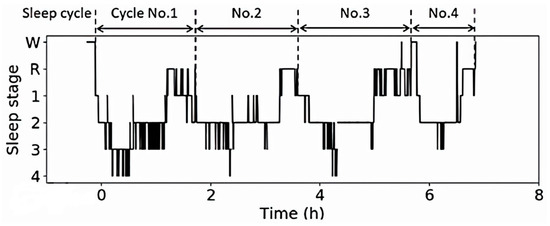
Figure 1.
Normal night sleep cycle [46].
Distinguishing various sleep states relies on EMG analysis during REM and non-REM (NREM) sleep, as well as the collection of other physiological signals such as brainwaves, heart rate fluctuations, and the frequency and intensity of body movements. Physiological data are collected through brainwave analysis to differentiate between sleep states and assess sleep quality. Conductive adhesive electrodes are placed externally on the cerebral cortex, allowing for the recording and analysis of the user’s brainwave energy distribution before, during, and after sleep using a physiological signal device. This analysis facilitates the evaluation of sleep state and quality. Electrocardiogram (ECG) measurements capture heart potential signals, enabling the recording and quantitative analysis of physiological parameters such as heartbeat intensity and frequency. This data acquisition provides insight into the subject’s relaxed and excited sleep states.
The categorization of sleep stages is rooted in brainwave analysis, which involves examining the transformation of potential brain energy from time to frequency through Fourier transform. When transitioning from wakefulness to sleep, changes in brainwave frequencies occur. During the awake state, alpha (8–13 Hz) and beta (13–30 Hz) brainwaves are more active. The rapid eye movement (REM) phase exhibits significant low-frequency brainwave signals (2–7 Hz) and heightened EMG activity. In non-REM (NREM) sleep, deep sleep phases (N3 and N4) are characterized by the presence of delta (0.5–4 Hz) and theta (4–7 Hz) waves, which constitute a substantial portion of the overall energy distribution. Notably, deep sleep stage N4 is dominated by delta waves [47].
Analyzing heartbeats during sleep involves the recording of each heartbeat cycle using physiological signal devices. These cycles begin with the electrical impulse of the sinoatrial node, leading to atrial and ventricular contractions. Electrocardiogram (ECG) results are subjected to three methods of analysis: time, frequency, and nonlinearity. Time domain analysis includes metrics such as the mean, standard deviation, and percentiles of the R-wave interval (refer to Figure 2). Frequency domain analysis involves Fourier or wavelet transform to distinguish energy distribution between sympathetic and parasympathetic nervous activities at both low (0.04–0.15 Hz) and high (0.15–0.4 Hz) frequencies. The nonlinear analysis encompasses graphical and parameter-based methods, with graphical analysis presenting ECG scatter plots that reveal trends in heart rate variability (HRV) [48].
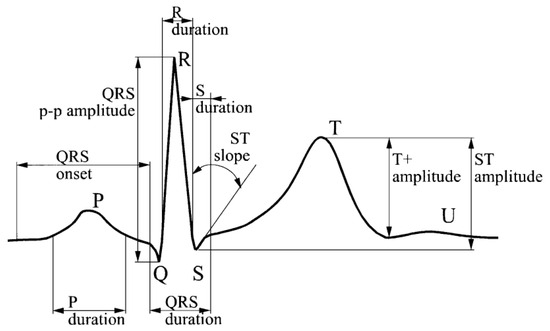
Figure 2.
Schematic diagram of the heartbeat cycle period.
2.3. Data Analysis
The algorithm model of data analysis consists of designing the sleep stages in a stepwise manner based on the data results of human brain waves, heartbeat, and turnover measured in the previous step. The collected brainwave activity information is filtered, segmented, and tagged, and the active high-frequency response and gentle low-frequency brainwave activity are quantitatively distinguished to determine the user’s actual sleep cycle. Combined with the data results regarding turnover and heartbeat, the sleep stage is divided into three phases: awake, REM, and not REM. The model analyzes each phase of sleep. To confirm the sleep stage by spectral analysis and marking brainwave signals, turnover information is added; the turnover time and intensity recorded by the accelerometer of the Apple Watch are analyzed; and the sleep stages with different power and turnover times are marked. As an illustration, REM sleep typically involves rapid eye movements and muscle paralysis, resulting in a heightened frequency of body movements and position changes. Conversely, during the transition to deep sleep stages within NREM sleep, the frequency of these movements diminishes, reflecting reduced turnover activity. In heartbeat analysis, the frequency and timing characteristics of heart rate variability are extracted by frequency spectral analysis and other processing, then matched with brain wave results to build a sleep stage model. For example, during REM sleep, the Beta and Alpha brain waves are more active, and the analysis results of heart rate variability are also excitatory, while during NREM sleep, the analysis results are relaxed. When the cloud sleep stage analysis algorithm model is updated, the sleep data are uploaded to the system by the user, the sleep stages are analyzed, and the analysis results are sent back to the user.
2.4. Brain Wave Analysis
Within the realm of frequency domain analysis, the initial time series data are transformed into the frequency domain by utilizing fast Fourier transform (FFT). This transformation enables the examination of the power spectral density (PSD). FFT enhances the computational efficiency of discrete Fourier transform calculations, expediting the overall process. In this context, x[k] represents the PSD resulting from the conversion from the time domain to the frequency domain, while x[n] signifies the discrete Fourier transform of the signal at n data points. This relationship is represented as follows:
Using Formula (1), brain waves can be divided into beta, alpha, theta, and delta waves, and the periodic changes of N1, N2, N3, and N4 from REM and REM can be distinguished by calculating and classifying the characteristic wave generation time of each interval.
2.5. HRV Analysis
When delving into the analysis of HRV concerning sympathetic and parasympathetic nervous activity within the time domain, one crucial metric is the standard deviation of NN intervals (SDNN). NN intervals correspond to the intervals between successive R-waves in the ECG signal. The calculation of SDNN can be outlined as follows:
In this context, where RRi represents the RR period in milliseconds, N denotes the total count of RR periods, the calculation for SDNN can be presented as:
The frequency domain analysis of HRV involves transforming each change in heartbeat interval into the frequency domain, then enabling the evaluation of sympathetic and parasympathetic nerve activities. This information is then expressed as the power frequency density, allowing for the exploration of physiological states across different time intervals. The calculation procedure is illustrated in Formula (1). By employing specific frequency ranges, the indices for sympathetic nerve activity (0.04–0.15 Hz, considered the low-frequency band) that signify wakefulness and heightened activity; parasympathetic nerve activity (0.15–0.4 Hz, categorized as the high-frequency band), which is representative of relaxation; and the sympathetic-to-parasympathetic activity balance index (LF-to-HF power ratio, denoted as LF/HF), which indicates the equilibrium between hyperactivity and relaxation, are derived.
2.6. Sleep Turn-Over Analysis
The analysis of sleep turnover states involves the capture of turnover data using an accelerometer, which is worn as a sleep bracelet. The accelerometer can discern movement and acceleration along the X, Y, and Z axes. It records these motion patterns over an extended period during sleep, enabling the inference of the frequency and extent of various sleep stages. Mathematician Leonard Euler introduced the notion that a rigid body’s position can be described within a three-dimensional space [49]. The definition and computation of this three-dimensional space involve three angles, represented as R (φ, θ, ψ), which are outlined as follows:
After the coordinate system is decomposed into a single rigid body, in turn, the gap between the current turned position and the original position can be calculated, and the combined calculation is as follows:
In this study, software services were adopted. Through the hybrid cloud architecture of Microsoft Windows Azure, according to the functions of data analysis and data storage, Azure Active Directory, Azure Blob Storage, Azure Databricks, and Azure SQL Data Warehouse were established for data integration. They provided users with structured tasks such as an access verification security mechanism, data access, and data analysis and return. Figure 3 shows an architectural diagram of the cloud data analysis system.
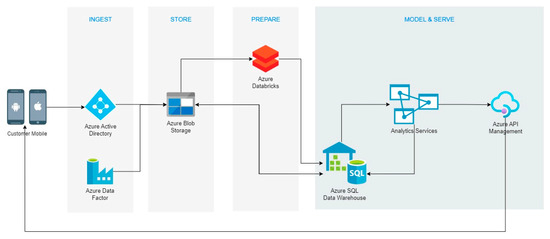
Figure 3.
Architecture diagram of the data analysis system.
2.7. Experimental Equipment
There were three types of equipment utilized for gathering information on physiological characteristics. The first was the MP150, manufactured by the Biopac Student Lab in the United States. The second was the wGT3X-BT wrist monitor produced by ActiGraph. Lastly, there is the Apple Watch Series 5, developed by Apple Inc., Cupertino, CA, USA. Among these, the MP150 by the Biopac Student Lab boasts multi-channel physiological recording capabilities. It can capture and record physiological signals like brain waves, electrocardiograms, electromyography, and electrooculograms. These signals can be analyzed using the jointly developed AcqKnowledge® 5.0 software, either within the software itself or via externally developed software (refer to Figure 4). The wGT3X-BT wrist monitor is designed for monitoring daily activities and sleep-related physiological data, including movement thresholds and turnover patterns. The accompanying ActiLife 6.0 software facilitates the analysis and normalization of movement patterns and intensity during wear. It can also assess the turnover frequency and swing during sleep, yielding results such as sleep cycles, latency, and sleep efficiency (as depicted in Figure 5). The Apple Watch Series 5 is a commercial-grade smart wearable with features like news updates, conference alerts, and message notifications. It incorporates advanced optical technology for heart rate recording using the optical volume variation method (Figure 6).
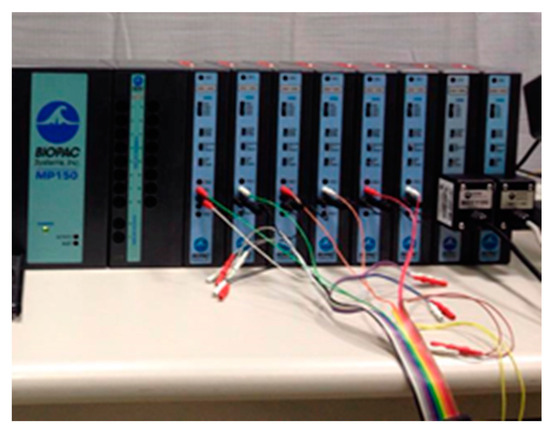
Figure 4.
The bio-physiological characteristic information collection equipment, specifically the MP150, includes an EEG (electroencephalogram) and ECG (electrocardiogram) physiological signal amplifier host [50].
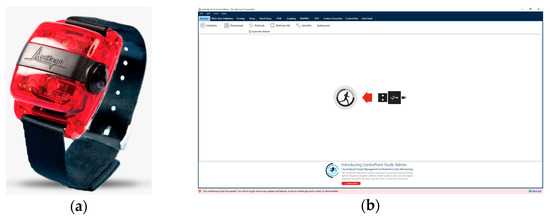
Figure 5.
The bio-physiological characteristic information collection equipment known as wGT3X-BT. (a) The WGT3x-BT wrist-meter host manufactured by ActiGraph. (b) The ActiLife analysis software, which was supplied by ActiGraph [50].
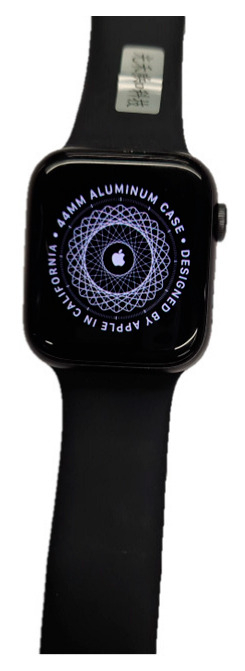
Figure 6.
Apple Watch 5 by Apple Inc.
2.8. Data Identify
This study validated the electrocardiogram (ECG) data, which were measured through the Biopac MP150 system. A two-stage data filtering process was employed to prevent the detection of motion artifacts caused by abnormal heartbeats. For each dataset, the R-R interval was compared to the average of the adjacent data points. If the average difference exceeded 30%, the data point was excluded. Subsequently, the remaining data points underwent a comprehensive average analysis, and a comparison was made with the remaining dataset. If the difference also exceeded 30%, the previous data exclusion process was repeated iteratively until the overall average of the remaining data points no longer differed by more than 30%. If the percentage of excluded data points exceeded 5% of the total dataset, the data for that particular user were entirely excluded and not used for analysis [51,52].
2.9. Experiemental Environment
In this study, we arranged a designated sleeping area for conducting the sleep experiments. The sleeping environment entailed a dimly lit room with black flannel fabric devoid of lighting fixtures. A bed measuring 1.8 m in length and 0.6 m in width was provided within the sleeping space. Adjacent to the bed, a Biopac MP150 apparatus was positioned to gather brain wave and electrocardiogram data, as illustrated in Figure 7.
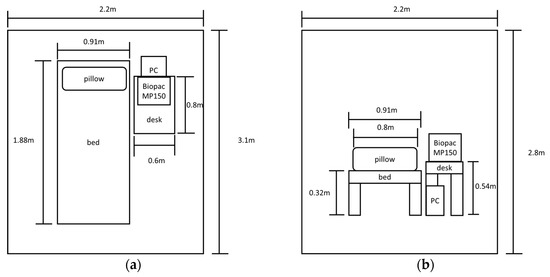
Figure 7.
Experimental environment: (a) floor plan; (b) side view [50].
3. Results and Discussion
3.1. Analysis Results and Discussion of Sleep Data
As shown in Figure 8, the total duration of the sleep analysis was 60 min, and statistical analysis was conducted once every 30 s. A total of 120 pieces of data were obtained, which captured the results of Delta, Theta, Alpha, and Beta brain waves, as well as the accelerometer Gyro. The horizontal axis of the graph was divided into 120 intervals, with each interval representing 30 s of physiological information.

Figure 8.
Brain waves measured during sleep and gyro analysis results.
Figure 9 shows the HRV analysis results during sleep. Sleep was divided into 11 sections. The first 3 min constituted the baseline, followed by 10 min as the first section. Then, each analysis street continued the previous section of data for 5 min and overlapped for the next 5 min until the end of sleep, for a total of 11 units. The findings revealed that during the initial 10 min of sleep, sympathetic nerve activity surpassed parasympathetic nerve activity. However, a shift occurred approximately 30 min into sleep, with the parasympathetic nerve activity beginning to outweigh the sympathetic nerve activity. When the sympathetic nerve activity was higher, the subject’s physiological condition was more focused and excited, meaning that they had not yet entered sleep at this time. On the contrary, the higher the parasympathetic nerve activity was, the closer became is to the situation during sleep. The analysis results demonstrated a positive correlation between brain waves, heartbeat, and gyroscope during sleep. As the sleep duration extended, the analysis outcomes for heart rate variability post-sleep exhibited a greater sense of relaxation. Moreover, there was an elevation in the presence of Delta waves in the brain wave patterns, coupled with a decrease in the recorded gyroscope response when the body underwent turnovers.
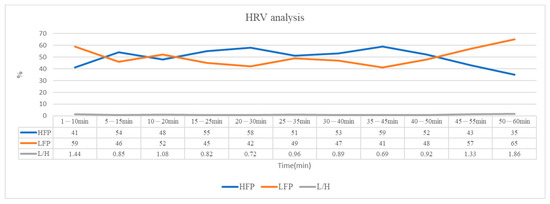
Figure 9.
HRV analysis data results.
3.2. Cloud Data Analysis System
The cloud sleep staging system quantified the brain wave, heartbeat, and gyro information through the sleep data of previous research, converted them into a database, and then introduced machine learning to establish a new data analysis model. The function of uploading background data was added by extending the mobile phone Sleep Assist App, developed in the early stages of this research. After the user agreed to collect, analyze, and post-process the physiological data, the data were uploaded and returned to the user’s app through online system analysis so that the user could obtain their sleep status results. As shown in Figure 10, the function flow of the sleep aid app and cloud analysis was followed.

Figure 10.
Sleep Assist App expands the functions of cloud analysis.
Figure 11 shows the HRV analysis results of the heartbeat data uploaded by the users. The data analysis results demonstrate that the results of professional physiological signal equipment acquisition analyses were similar to the analyses of wearable devices after sleeping for 15 min until waking up.

Figure 11.
HRV analysis results of heartbeat data uploaded by users.
According to the HRV analysis results in Figure 9 and Figure 11, the tendency of the subjects to relax grew stronger and stronger at 10–20 min, and after sleeping for 45 min, the relaxed states began to slowly end and the subjects gradually returned to an awake state. The analysis results of the professional physiological signal equipment showed sensitivity, with evident relaxation and excitement alternating in the trend, while the analysis results of physiological signals captured by wearing devices changed slightly and tended to be relaxed. The analysis results of intelligent wearable devices were inconsistent with the results of professional physiological signal acquisition equipment before waking up and falling asleep for 20 min. Still, they were highly compatible with the analysis results of professional physiological signal equipment after sleeping for 20 min.
4. Conclusions
Prior research has shown that collecting physiological data via polysomnography can lead to wearer discomfort during sleep [53,54,55]. In light of this, our study introduces an algorithmic analysis module tailored for the interpretation of physiological data harnessed from intelligent wearable devices. This module harmonizes the acquired physiological data from smart wearables with closely correlated data derived from polysomnography, thereby delineating sleep stages. The primary focus of this investigation revolves around the enhancement of sleep quality, encompassing the following key facets:
- A novel sleep state algorithm is proffered for interpreting sleep stages using physiological signals from smart wearable devices. The primary objective is to mitigate the reliance on conventional physiological signal acquisition instruments that necessitate direct physical contact with the body.
- Through a comprehensive analysis of cloud-based databases and the uploading of personalized physiological data, our study presents an iterative updating mechanism for personalized and precise sleep algorithms. Each set of individual physiological data is subjected to a secondary analysis compared to the original dataset, facilitating the calibration of individual physiological data algorithms. These refinements consider variations in physiological markers during periods of inactivity as well as the frequency of bodily movements.
- Our research extends beyond prior endeavors in dynamic sleep-inducing illumination [50,56,57,58], aiming to minimize undue physiological data acquisition and re-shape the paradigm of physiological data analysis from smart wearable devices. Prospective work entails utilizing physiological data harnessed by wearable devices to conduct sleep state analyses, enabling refinements to dynamic sleep-inducing illumination, and amplifying users’ sleep efficiency.
Author Contributions
Methodology, Y.-K.W. and C.-Y.C.; Formal analysis, Y.-K.W.; Investigation, C.-Y.C.; Data curation, Y.-K.W.; Writing—original draft, Y.-K.W. and C.-Y.C.; Project administration, C.-Y.C. All authors have read and agreed to the published version of the manuscript.
Funding
This research was funded by the National Science and Technology Council of Taiwan under contract No. 112-2218-E-011-005-MBK.
Institutional Review Board Statement
This study obtained approval from the Institutional Review Board of National Taiwan University for conducting a human factor experiment. The experiment was granted approval under the reference number 202007EM041.
Informed Consent Statement
Informed consent was obtained from all volunteers involved in the study. Written informed consent has been obtained from the patient(s) to publish this paper.
Data Availability Statement
All data generated or analyzed to support the findings of the present study are included this article. The raw data can be obtained from the authors, upon reasonable request.
Acknowledgments
We thank the technical consulting of OSENCE Technology and Zhi-Wei Wang & Chih-Hao Chuang for performing the studies.
Conflicts of Interest
The authors declare no conflict of interest.
References
- Wang, H.; He, L.; Gao, Y.; Gao, X.; Lei, X. Effects of physical activity and sleep quality on well-being: A wrist actigraphy study during the pandemic. Appl. Psychol. Health Well-Being 2021, 13, 394–405. [Google Scholar] [CrossRef] [PubMed]
- Engle-Friedman, M.; Riela, S.; Golan, R.; Ventuneac, A.M.; Davis, C.M.; Jefferson, A.D.; Major, D. The effect of sleep loss on next day effort. J. Sleep Res. 2003, 12, 113–124. [Google Scholar] [CrossRef] [PubMed]
- Vgontzas, A.N.; Zoumakis, E.; Bixler, E.O.; Lin, H.M.; Follett, H.; Kales, A.; Chrousos, G.P. Adverse effects of modest sleep restriction on sleepiness, performance, and inflammatory cytokines. J. Clin. Endocrinol. Metab. 2004, 89, 2119–2126. [Google Scholar] [CrossRef] [PubMed]
- Haack, M.; Sanchez, E.; Mullington, J.M. Elevated inflammatory markers in response to prolonged sleep restriction are associated with increased pain experience in healthy volunteers. Sleep 2007, 30, 1145–1152. [Google Scholar] [CrossRef]
- Mullington, J.M.; Haack, M.; Toth, M.; Serrador, J.M.; Meier-Ewert, H.K. Cardiovascular, inflammatory, and metabolic consequences of sleep deprivation. Prog. Cardiovasc. Dis. 2009, 51, 294–302. [Google Scholar]
- Smolensky, M.H.; Di Milia, L.; Ohayon, M.M.; Philip, P. Sleep disorders, medical conditions, and road accident risk. Accid. Anal. Prev. 2011, 43, 533–548. [Google Scholar]
- Ebrahimi, M.H.; Sadeghi, M.; Dehghani, M.; Niiat, K.S. Sleep habits and road traffic accident risk for Iranian occupational drivers. Int. J. Occup. Med. Env. Health 2015, 28, 305–312. [Google Scholar]
- Hystad, S.W.; Nielsen, M.B.; Eid, J. The impact of sleep quality, fatigue and safety climate on the perceptions of accident risk among seafarers. Eur. Rev. Appl. Psychol. 2017, 67, 259–267. [Google Scholar]
- Ohayon, M.; Wickwire, E.M.; Hirshkowitz, M.; Albert, S.M.; Avidan, A.; Daly, F.J.; Dauvilliers, Y.; Ferri, R.; Fung, C.; Gozal, D.; et al. National Sleep Foundation’s sleep quality recommendations: First report. Sleep Health 2017, 3, 6–19. [Google Scholar] [CrossRef]
- Sadeh, A.; Keinan, G.; Daon, K. Effects of stress on sleep: The moderating role of coping style. Health Psychol. 2004, 23, 542. [Google Scholar] [CrossRef]
- Han, K.S.; Kim, L.; Shim, I. Stress and sleep disorder. Exp. Neurobiol. 2012, 21, 141. [Google Scholar] [CrossRef] [PubMed]
- Fullagar, H.H.; Duffield, R.; Skorski, S.; Coutts, A.J.; Julian, R.; Meyer, T. Sleep and recovery in team sport: Current sleep-related issues facing professional team-sport athletes. Int. J. Sports Physiol. Perform. 2015, 10, 950–957. [Google Scholar] [CrossRef] [PubMed]
- Kredlow, M.A.; Capozzoli, M.C.; Hearon, B.A.; Calkins, A.W.; Otto, M.W. The effects of physical activity on sleep: A meta-analytic review. J. Behav. Med. 2015, 38, 427–449. [Google Scholar] [PubMed]
- Bosma, K.J.; Ranieri, V.M. Filtering out the noise: Evaluating the impact of noise and sound reduction strategies on sleep quality for ICU patients. Crit. Care 2009, 13, 151. [Google Scholar] [CrossRef] [PubMed]
- Bion, V.; Lowe, A.S.; Puthucheary, Z.; Montgomery, H. Reducing sound and light exposure to improve sleep on the adult intensive care unit: An inclusive narrative review. J. Intensive Care Soc. 2018, 19, 138–146. [Google Scholar] [CrossRef]
- Jensen, H.I.; Markvart, J.; Holst, R.; Thomsen, T.D.; Larsen, J.W.; Eg, D.M.; Nielsen, L.S. Shift work and quality of sleep: Effect of working in designed dynamic light. Int. Arch. Occup. Environ. Health 2016, 89, 49–61. [Google Scholar] [CrossRef]
- Harper, K. So Tired in the Morning…The Science of Sleep; ChemMatters: Washington, DC, USA, 2015. [Google Scholar]
- Solso, R.L. The Psychology of Art and the Evolution of the Conscious Brain; MIT Press: Cambridge, MA, USA; London, UK, 2003; p. 57. [Google Scholar]
- Berson, D.M.; Dunn, F.A.; Takao, M. Phototransduction by retinal ganglion cells that set the circadian clock. Science 2002, 295, 1070–1073. [Google Scholar] [CrossRef]
- Morin, L.P. The circadian visual system. Brain Res. Rev. 1994, 19, 102–127. [Google Scholar]
- Axelrod, J. The pineal gland: A neurochemical transducer. Science 1974, 184, 1341–1348. [Google Scholar] [CrossRef]
- Chellappa, S.L.; Steiner, R.; Oelhafen, P.; Lang, D.; Götz, T.; Krebs, J.; Cajochen, C. Acute exposure to evening blue-enriched light impacts on human sleep. J. Sleep Res. 2013, 22, 573580. [Google Scholar] [CrossRef]
- Klink, M.E. Risk factors associated with complaints of insomnia in a general adult population: Influence of previous complaints of insomnia. Arch. Intern. Med. 1992, 152, 1634–1637. [Google Scholar] [CrossRef] [PubMed]
- Ohayon, M.M. Epidemiology of insomnia: What we know and what we still need to learn. Sleep Med. Rev. 2002, 6, 97–111. [Google Scholar] [CrossRef] [PubMed]
- Roth, T.; Ancoli-Israel, S. Daytime consequences and correlates of insomnia in the United States: Results of the 1991 National Sleep Foundation Survey. II. Sleep J. Sleep Res. Sleep Med. 1999, 22, S354–S358. [Google Scholar]
- Tonks, A. Children who sleep with light on may damage their sight. BMJ Br. Med. J. 1999, 318, 1369. [Google Scholar] [CrossRef][Green Version]
- Fonken, L.K.; Nelson, R.J. The effects of light at night on circadian clocks and metabolism. Endocr. Rev. 2014, 35, 648–670. [Google Scholar] [CrossRef]
- Ursino, G.; Coppari, R. Insulin under the influence of light. Swiss Med. Wkly. 2020, 150, w20273. [Google Scholar] [CrossRef] [PubMed]
- Cheung, I.N.; Zee, P.C.; Shalman, D.; Malkani, R.G.; Kang, J.; Reid, K.J. Morning and evening blue-enriched light exposure alters metabolic function in normal weight adults. PLoS ONE 2016, 11, e0155601. [Google Scholar] [CrossRef]
- Park YM, M.; White, A.J.; Jackson, C.L.; Weinberg, C.R.; Sandler, D.P. Association of exposure to artificial light at night while sleeping with risk of obesity in women. JAMA Intern. Med. 2019, 179, 1061–1071. [Google Scholar] [CrossRef]
- Obayashi, K.; Yamagami, Y.; Kurumatani, N.; Saeki, K. Bedroom lighting environment and incident diabetes mellitus: A longitudinal study of the HEIJO-KYO cohort. Sleep Med. 2020, 65, 1–3. [Google Scholar] [CrossRef]
- Kozaki, T.; Kitamura, S.; Higashihara, Y.; Ishibashi, K.; Noguchi, H.; Yasukouchi, A. Effect of color temperature of light sources on slow-wave sleep. J. Physiol. Anthropol. Appl. Hum. Sci. 2005, 24, 183–186. [Google Scholar] [CrossRef]
- Smolders, K.C.; de Kort, Y.A. Investigating daytime effects of correlated colour temperature on experiences, performance, and arousal. J. Environ. Psychol. 2017, 50, 80–93. [Google Scholar] [CrossRef]
- Lu, Y. Design of a Sleep Assistance System Terminalm. In Proceedings of the 2020 IEEE 5th Information Technology and Mechatronics Engineering Conference (ITOEC), Chongqing, China, 12–14 June 2020; IEEE: New York, NY, USA, 2020; pp. 1586–1589. [Google Scholar]
- Saad, W.H.M.; Khoo, C.W.; Ab Rahman, S.I.; Ibrahim, M.M.; Saad, N.H.M. Development of sleep monitoring system for observing the effect of the room ambient toward the quality of sleep. In IOP Conference Series: Materials Science and Engineering; IOP Publishing: Bristol, UK, 2017; Volume 210, p. 012050. [Google Scholar]
- Sridhar, N.; Shoeb, A.; Stephens, P.; Kharbouch, A.; Ben Shimol, D.; Burkart, J.; Ghoreyshi, A.; Myers, L. Deep learning for automated sleep staging using instantaneous heart rate. NPJ Digit. Med. 2020, 3, 106. [Google Scholar] [CrossRef] [PubMed]
- Zhang, R.; Campanella, C.; Aristizabal, S.; Jamrozik, A.; Zhao, J.; Porter, P.; Ly, S.; Bauer, B.A. Impacts of dynamic LED lighting on the well-being and experience of office occupants. Int. J. Environ. Res. Public Health 2020, 17, 7217. [Google Scholar] [CrossRef]
- Jakobsen, G.; Engstrøm, M.; Thronæs, M.; Løhre, E.T.; Kaasa, S.; Fayers, P.; Hjermstad, M.J.; Klepstad, P. Sleep quality in hospitalized patients with advanced cancer: An observational study using self-reports of sleep and actigraphy. Support. Care Cancer 2020, 28, 2015–2023. [Google Scholar] [CrossRef] [PubMed]
- Chang, W.P.; Peng, Y.X. Meta-analysis of differences in sleep quality based on actigraphs between day and night shift workers and the moderating effect of age. J. Occup. Health 2021, 63, e12262. [Google Scholar] [CrossRef] [PubMed]
- Zhu, J.; Liu, X.; Shi, Q.; He, T.; Sun, Z.; Guo, X.; Liu, W.; Bin Sulaiman, O.; Dong, B.; Lee, C. Development trends and perspectives of future sensors and MEMS/NEMS. Micromachines 2019, 11, 7. [Google Scholar] [CrossRef]
- International Data Corporation (IDC). Worldwide Wearables Shipments Surge 94.6% in 3Q 2019 Led by Expanding Hearables Market, Says IDC. Available online: https://www.businesswire.com/news/home/20191209005097/en/Worldwide-Wearables-Shipments-Surge-94.6-in-3Q-2019-Led-by-Expanding-Hearables-Market-Says-IDC (accessed on 30 August 2023).
- Kemp, S. Digital 2020: Global Digital Overview. Datareportal. 2020. Available online: https://datareportal.com/reports/digital-2020-global-digital-overview (accessed on 30 August 2023).
- Aserinsky, E.; Kleitman, N. Regularly occurring periods of eye motility, and concomitant phenomena, during sleep. Science 1953, 118, 273e4. [Google Scholar] [CrossRef]
- Iber, C.; Ancoli-Israel, S.; Chesson, A.; Quan, S.F. (Eds.) The AASM Manual for the Scoring of Sleep and Associated Events: Rules, Terminology, and Technical Specification, 1st ed.; American Academy of Sleep Medicine: Westchester, IL, USA, 2007. [Google Scholar]
- Rechtschaffen, A.; Kales, A. (Eds.) A Manual of Standardized Terminology, Techniques and Scoring System of Sleep Stages in Human Subjects; Brain Information Service/Brain Research Institute, University of California: Los Angeles, CA, USA, 1968. [Google Scholar]
- Sawai, H.; Matsumoto, M.; Koyama, E. The relationship between each length of REM-NREM sleep cycle and sleep stage. In Proceedings of the 2021 IEEE 3rd Global Conference on Life Sciences and Technologies (LifeTech), Nara, Japan, 9–11 March 2021; IEEE: New York, NY, USA, 2021; pp. 171–172. [Google Scholar]
- Maeda, M.; Takajyo, A.; Inoue, K.; Kumamaru, K.; Matsuoka, S. Time-frequency analysis of human sleep EEG and its application to feature extraction about biological rhythm. In Proceedings of the SICE Annual Conference 2007, Takamatsu, Japan, 17–20 September 2007; IEEE: New York, NY, USA, 2007; pp. 1939–1944. [Google Scholar]
- Ek, F.S.; Jakovljević, M. Heart rate variability—A shape analysis of Lorenz plots. Cell. Mol. Biol. Lett. 2002, 7, 160. [Google Scholar]
- Biedenharn, L.C.; Louck, J.D.; Carruthers, P.A. Angular momentum in quantum physics—Theory and application. In Encyclopedia of Mathematics and Its Applications; Addison-Wesley: Reading, MA, USA, 1981. [Google Scholar]
- Chen, C.Y.; Wang, Y.K.; Wang, Z.W. Research on the application of the dynamic assisted sleep light to smart mobile devices. Appl. Sci. 2022, 12, 5191. [Google Scholar] [CrossRef]
- Wichterle, D.; Simek, J.; La Rovere, M.T.; Schwartz, P.J.; Camm, A.J.; Malik, M. Prevalent low-frequency oscillation of heart rate: Novel predictor of mortality after myocardial infarction. Circulation 2004, 110, 1183–1190. [Google Scholar] [CrossRef]
- Wiklund, U.; Hörnsten, R.; Karlsson, M.; Suhr, O.B.; Jensen, S.M. Abnormal heart rate variability and subtle atrial arrhythmia in patients with familial amyloidotic polyneuropathy. Ann. Noninvasive Electrocardiol. 2008, 13, 249–256. [Google Scholar] [CrossRef] [PubMed]
- Mousailidis G, Κ.; Lachanas, V.A.; Vasdeki, A.; Alexopoulos, E.I.; Kaditis, A.G.; Petinaki, E.; Balatsos, N.A.A.; Bizakis, J.G.; Skoulakis, C.E. Urine concentrations changes of cysteinyl leukotrienes in non-obese children with obstructive sleep apnea undergoing adenotonsillectomy. Int. J. Pediatr. Otorhinolaryngol. 2018, 115, 149–152. [Google Scholar] [CrossRef] [PubMed]
- Iqubal MF, B.M.; Lam, Y.Y. Home-based monitoring and alert system for Sleep Apnea patients. In Proceedings of the 2020 IEEE 7th International Conference on Engineering Technologies and Applied Sciences (ICETAS), Kuala Lumpur, Malaysia, 18–20 December 2020; IEEE: New York, NY, USA, 2020; pp. 1–4. [Google Scholar]
- Khurana, S.; Soda, N.; Shiddiky, M.J.; Nayak, R.; Bose, S. Current and future strategies for diagnostic and management of obstructive sleep apnea. Expert Rev. Mol. Diagn. 2021, 21, 1287–1301. [Google Scholar] [CrossRef] [PubMed]
- Chen, H.W.; Chen, C.Y.; Wu, P.J. The Influence of Lighting on Human Circadian Rhythms. In Proceedings of the 2019 16th China International Forum on Solid State Lighting & 2019 International Forum on Wide Bandgap Semiconductors China (SSLChina: IFWS), Shenzhen, China, 25–27 November 2019; IEEE: New York, NY, USA, 2019; pp. 185–188. [Google Scholar]
- Chen, C.Y.; Wang, Y.K. Dynamic color temperature sleep assitant light implemented on the mobile device. In Proceedings of the 2020 Fifth Junior Conference on Lighting (Lighting), Ruse, Bulgaria, 24–26 September 2020; IEEE: New York, NY, USA, 2020; pp. 1–4. [Google Scholar]
- Chen, C.Y.; Chen, H.W. The Effect of dynamic lighting for working shift people on clinical heart rate variability and human slow wave sleep. Appl. Sci. 2022, 12, 2284. [Google Scholar] [CrossRef]
Disclaimer/Publisher’s Note: The statements, opinions and data contained in all publications are solely those of the individual author(s) and contributor(s) and not of MDPI and/or the editor(s). MDPI and/or the editor(s) disclaim responsibility for any injury to people or property resulting from any ideas, methods, instructions or products referred to in the content. |
© 2023 by the authors. Licensee MDPI, Basel, Switzerland. This article is an open access article distributed under the terms and conditions of the Creative Commons Attribution (CC BY) license (https://creativecommons.org/licenses/by/4.0/).